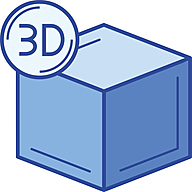POSS Nanocomposite Hydrogel for 3D Bioprinting
TECHNOLOGY NUMBER: 7700

OVERVIEW
A nanocomposite material with enhanced gelling kinetics and mechanical stability- Enhanced physical properties such as mechanical stability, deformability, swelling rate, and gelling kinetics
- Fully biocompatible and free from a need to use harsh or toxic reagents for stability or gelation
BACKGROUND
Three-dimensional (3D) bioprinting is a tissue engineering technique that can produce biocompatible, complex structures from digital models in a manner which is analogous to conventional 3D printing for plastic based materials. This outcome is accomplished using materials collectively known as bioinks, which include broad classes of compounds such as hydrogels or decellularized extracellular matrix proteins to create synthetic organ-like structures. A significant advantage of bioprinting over conventional tissue engineering resides in its ability to produce well organized multicellular structures as well as bioligands and signaling molecules that can direct cellular assembly and architecture, mimicking the dynamics of organioid formation. The greatest limitation in the bioprinting industry has been the development of printer compatible bioinks that are affordable, that can be loaded with drugs or signaling molecules, and that maintain their designed shape during handling and for a defined time post grafting to the host organism. As such, a need exists for new methods to optimize this technology.
INNOVATION
Researchers have invented a nanocomposite material in which nanoparticles have been embedded in a printer-compatible master hydrogel matrix. This nanocomposite material confers enhanced physical properties such as mechanical stability, deformability, swelling rate, and gelling kinetics relative to currently available solutions on the market. The nanoparticles themselves, as well as the materials comprising the master matrix, have been shown to be fully biocompatible and do not require harsh or toxic reagents for stability or gelation. These nanoparticles also permit an opportunity to incorporate drugs or signaling molecules which can provide a potentially attractive approach for localized therapeutic delivery in transplanted host organisms.